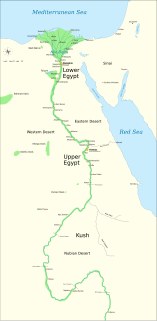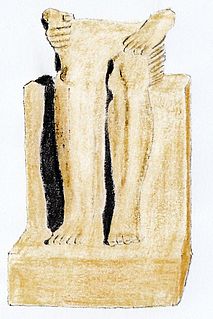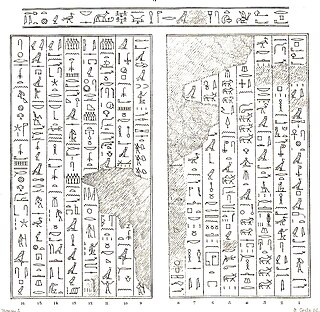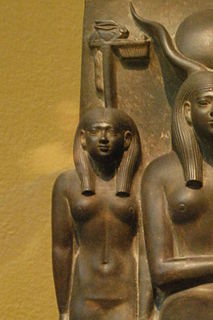
The First Intermediate Period, described as a 'dark period' in ancient Egyptian history, spanned approximately one hundred and twenty-five years, from c. 2181–2055 BC, after the end of the Old Kingdom. It comprises the Seventh, Eighth, Ninth, Tenth, and part of the Eleventh Dynasties. The concept of a "First Intermediate Period" was coined in 1926 by Egyptologists Georg Steindorff and Henri Frankfort.

The Middle Kingdom of Egypt is the period in the history of ancient Egypt following a period of political division known as the First Intermediate Period. The Middle Kingdom lasted from approximately 2040 to 1782 BCE, stretching from the reunification of Egypt under the reign of Mentuhotep II in the Eleventh Dynasty to the end of the Twelfth Dynasty. The kings of the Eleventh Dynasty ruled from Thebes and the kings of the Twelfth Dynasty ruled from el-Lisht.
A nomarch was a provincial governor in ancient Egypt; the country was divided into 42 provinces, called nomes. A nomarch was the government official responsible for a nome.
The Eighth Dynasty of ancient Egypt is a poorly known and short-lived line of pharaohs reigning in rapid succession in the early 22nd century BC, likely with their seat of power in Memphis. The Eighth Dynasty held sway at a time referred to as the very end of the Old Kingdom or the beginning of the First Intermediate Period. The power of the pharaohs was waning while that of the provincial governors, known as nomarchs, was increasingly important, the Egyptian state having by then effectively turned into a feudal system. In spite of close relations between the Memphite kings and powerful nomarchs, notably in Coptos, the Eighth Dynasty was eventually overthrown by the nomarchs of Heracleopolis Magna, who founded the Ninth Dynasty. The Eighth Dynasty is sometimes combined with the preceding Seventh Dynasty, owing to the lack of archeological evidence for the latter which may be fictitious.

Mentuhotep I may have been a Theban nomarch and independent ruler of Upper Egypt during the early First Intermediate Period. Alternatively, Mentuhotep I may be a fictional figure created during the later Eleventh Dynasty, which rose to prominence under Intef II and Mentuhotep II, playing the role of a founding father.

Sehertawy Intef I was a local nomarch at Thebes during the early First Intermediate Period and the first member of the 11th Dynasty to lay claim to a Horus name. Intef reigned from 4 to 16 years c. 2120 BC or c. 2070 BC during which time he probably waged war with his northern neighbor, the Coptite nomarch Tjauti. Intef was buried in a saff tomb at El-Tarif, known today as Saff el-Dawaba.

Beni Hasan is an ancient Egyptian cemetery. It is located approximately 20 kilometers (12 mi) to the south of modern-day Minya in the region known as Middle Egypt, the area between Asyut and Memphis.

Sekhemkare Amenemhat V was an Egyptian pharaoh of the 13th Dynasty during the Second Intermediate Period. According to Egyptologists Kim Ryholt and Darrell Baker, he was the 4th king of the dynasty, reigning from 1796 BC until 1793 BC. The identity of Amenemhat V is debated by a minority of Egyptologists, as he could be the same person as Sekhemkare Amenemhat Sonbef, the second ruler of the 13th Dynasty.
Amenemḥat or Amenemhēt, hellenized as Ammenémēs or as Ammanémēs, is an Ancient Egyptian name meaning "Amun is in front". Amenemhat was the name of a number of kings, princes and administration officials throughout ancient Egyptian history.
Kheti is a Sanskrit word, meaning farming.
Mentuhotep is an ancient Egyptian name meaning "Montu is satisfied" and may refer to:

Merhotepre Ini was the successor of Merneferre Ay, possibly his son, and the thirty-third king of the Thirteenth Dynasty of Egypt. He is assigned a brief reign of 2 Years, 3 or 4 Months and 9 days in the Turin Canon and lived during the early 17th century BC.

Sobeknakht II was an ancient Egyptian local Governor at El-Kab and a supporter of the Theban 16th or 17th Dynasty during the Second Intermediate Period.
The Abydos Dynasty is hypothesized to have been a short-lived local dynasty ruling over parts of Middle and Upper Egypt during the Second Intermediate Period in Ancient Egypt. The Abydos Dynasty would have been contemporaneous with the Fifteenth and Sixteenth Dynasties, from approximately 1650 to 1600 BC. It would have been based in or around Abydos and its royal necropolis might have been located at the foot of the Mountain of Anubis, a hill resembling a pyramid in the Abydene desert, close to a rock-cut tomb built for pharaoh Senusret III.

Sekhemraneferkhau Wepwawetemsaf was an Egyptian pharaoh during the Second Intermediate Period. According to the Egyptologists Kim Ryholt and Darrell Baker, he was a king of the Abydos Dynasty, although they leave his position within this dynasty undetermined. Alternatively, the Egyptologist Jürgen von Beckerath sees Wepwawetemsaf as a king of the late 13th Dynasty, while Marcel Marée proposes that he was a king of the late 16th Dynasty.

Khui was an ancient Egyptian kinglet during the early First Intermediate Period. Khui may have belonged to the Eighth Dynasty of Egypt, as Jürgen von Beckerath has proposed, or he may instead have been a provincial nomarch who proclaimed himself king.

Tefibi was an ancient Egyptian nomarch of the 13th nomos of Upper Egypt during the 10th Dynasty. In addition, he also was hereditary prince, count, wearer of the royal seal, sole companion and high priest of Wepwawet. The main source about his life came from his biography, inscribed on the "tomb III" in Asyut.

The Oryx nome was one of the 42 nomoi in ancient Egypt. More precisely, it was the 16th nome of Upper Egypt. It was named after the Scimitar oryx, and was roughly located in the territories surrounding the modern city of Minya in Middle Egypt.

The Hare nome, also called the Hermopolite nome was one of the 42 nomoi in ancient Egypt; more precisely, it was the 15th nome of Upper Egypt.
The Juridical Stela or Cairo Juridical Stela is an ancient Egyptian stele issued in c.1650 BCE. Kept at the Cairo Museum, its main purpose is to document the sale of a government office.












